|
| Steaks, Burgers and
Chops |
|
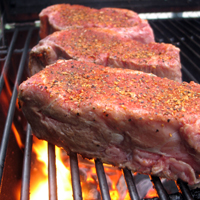
Thick steaks are easier to grill.
You have more time to get the
outside perfect before the center
is over cooked.

Don't let the steaks sit over a
flare-up very long. In fact, in
Argentina, this is considered
a rookie mistake because the
raw flame can cause an oily taste.
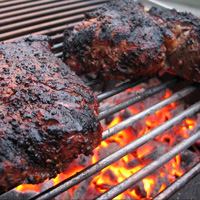
This is a "black and blue" or
"Pittsburgh style" strip steak.
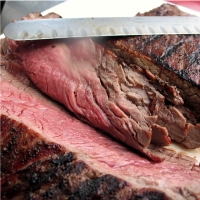
Flank steaks that were grilled
for fajitas. Notice how the steak
is medium rare from edge to edge.
Good grilling technique. It takes
high heat to accomplish this on
a thin cut of meat like flank steak.
|
The Perfect Steak
Let your steaks
come up to room temperature outside the refrigerator. This can take an hour or more. About a half
hour before they go on the grill, salt both sides with kosher salt. Watch for the salt to draw out
some moisture from the meat and start to bead up on the surface.This takes 10 minutes or so. When
it happens, add your rub. Now watch and the meat will re-absorb the salt and some of the flavor of
the rub over the next hour or so.
Light up a good Hickory or Red Oak lump
charcoal, raise the coal basket, and get your grate hotter than the hubs of you-know-where. You
need intense heat to do this correctly. Oil the grate and gently place the steaks. Use tongs, not a
spatula. When they release from the grate (and they will, just be patient), rotate them once to
generate cross hatch char marks and to avoid burning too deeply into the steak with the first set
of grill marks. You don't really want the meat to burn and change texture at the char marks. Flip
and repeat.
At this point, the most certain method is to
place a thermometer with a remote probe into the side of the thinnest steak*. Set the thermometer
to 125. Wait for the beep.
Move the steaks off the indirect heat to the
resting zone of the grill, or completely off the grill if you don't have an indirect zone, (if
off-grill, cover with foil) and wait at least five minutes for the juices to reabsorb. All the
moisture in the meat "retreats" to the center of the cut because the meat proteins tighten up when
they get hot and force out the flavorful juices. You have to give it time to relax and allow them
to re-distribute from edge to edge. The temperature will rise about ten degrees to
Medium.
A few other tips: Keep turning the
steaks as they rest. I think this makes them even more tender. If you're feeling particularly
decadent, use my Grandpa's trick and put a pat of butter on the steak while it's resting-it could
even be herbed butter-which combines with the juices for even more flavor.
If you like your steaks truly rare, set the
thermometer to 115. This technique will produce juicy steaks that are charred and spiced on the
outside and perfectly medium rare all the way through without the grey stripes top and bottom. Be
careful. While the steak is over the fire its internal temperature will rise at 10 degrees PER
MINUTE! So the difference between a perfect medium-rare steak and shoe leather is three
minutes.
(*Also, not to be a nag, but a true grill chef would call you lazy for using
a thermometer. It means you haven't mastered the chef's touch, and you poked a hole and let the
juice run out. If you plan to keep investing in good meat, get serious about it! You need practice
by grilling hundreds of steaks so you can tell what the internal temperature is by touch. It's a
necessary skill for a true master. Of course, if there is beer involved, we recommend that you
always use a thermometer.)
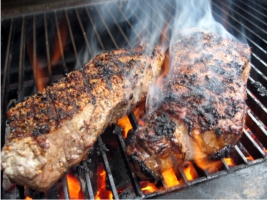
Notice the pepper crust on the meat.
This is the classic "Steak au Poivre"
done over charcoal. Excellent.
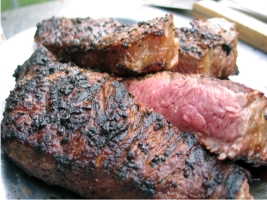
The Pittsburgh style steak after
resting.
|
|
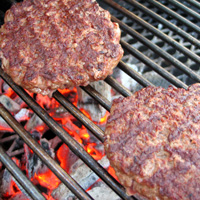
|
Basic
Burgers
Don't use extra lean hamburger. You want 85/15
hamburger so there is some juiciness in the meat. There is simply no way to make lean hamburger
stay juicy on the grill. Cruel fact.
There are two schools of thought on what to do next, and it really
boils down to whether you like your hamburgers pink in the middle or not. If you cook a hamburger
until it is gray all the way through, it will be too dry for most tastes. In all things grilled,
well done and juicy do not happen together. The only way to get a juicy burger is to cook it until
only barely pink in the middle. However, pink means that some of the meat may not have come up
to the full 140+ degrees required by most food safety guidelines. If you trust that your
hamburger is freshly ground under clean conditions, use method one and get a naturally juicy
burger. If not, skip down to method number two.
METHOD
ONE:
Handle the meat as
little as possible. Form the burgers thick-close to an inch. Warm them to room
temperature on the counter before they go on the grill. Salt and pepper both sides generously
at the last minute. Raise the lever for high searing heat. The grate must be hot-you need a
ton of heat for this. Throw on a handful of smoke chips (do this right away because they
won't get any smoke flavor once the outside is seared) and then lightly place the burgers on
the grill. Don't close the cover. Generate some char marks, rotate 90 degrees so the
grate doesn't burn in too deep, flip and repeat. When the inside is at 125° move them off the
fire to the right side of the grill to rest for at least five minutes. Flip them a few times
while they are resting and they will be much juicier. The interior temperature will rise to
about 140°, just a hint of pink.
METHOD TWO:
Mix a pound of hamburger with a large slice of white bread that
has been mashed into a tablespoon of milk. It will form a paste that chefs call a
"panade". (This also works for meatballs in any form.) Add the meat to the bowl along with
salt, pepper, finely chopped onion and mix it to an even consistency. If you want to take this to
the limit, add five or six tablespoons of bacon grease to the mixture. Now form your patties and
proceed to the grill-same routine as explained in METHOD ONE, but don't use quite as much heat, or
you'll burn the outside. You can cook these gray all the way through and they will still be juicy
and flavorful.
Here is where you begin your sacred hamburger
preparation ritual. Add onion salt, steak sauce, tabasco, cheese, i.e., doctor 'em up the way
you've been eating burgers your entire life. I offer no advice on condiments, buns, cheese or
beverage, but using this minimalist procedure you will have the juiciest, most perfect first step
on the stairway to hamburger heaven.
|
| |
|
|
 Back to top | Back to top |  Print this page | Print this page |  Bookmark this page Bookmark this page
Here is a little trick to learn the "chef's touch". It will help you develop a feel for how to
tell if a steak is done the way you like it without cutting into it or poking a hole with a
thermometer.
Always let your steaks rest for five or ten minutes on the
indirect side of the grill to reabsorb the juices. They continue cooking while they rest, so consider this
when you decide when to move them off the coals. Also, keep flipping the steaks while they are resting
because it seems to me they end up juicier.
Of course, the
best way to learn how to grill is to do a lot of grilling. So just keep buying steaks, poking, testing, eating, and
practice, practice, practice.
Tough work, but somebody's gotta do it!
Mastering the Chef's Touch for steaks (and salmon, scallops,
etc...)
|
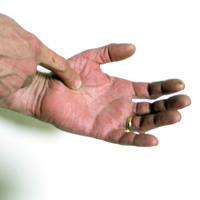
|
Find the Spot.
Find the point at the base of your thumb (usually
right above the bottom of the lifeline) that feels like a piece of raw beef. You might have to poke
around to find it. Choose the "meatiest" place that has the most "give" to
it.
|
|
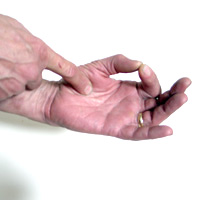
|
Thumb to Pointer finger = Medium/Rare.
Touch thumb and pointer finger together very lightly and notice how the spot
tightens a bit when you poke it. This is roughly how a medium-rare steak will feel if you poke it
on the grill.
|
|
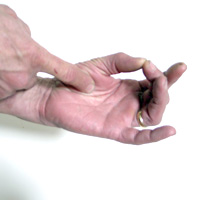
|
Thumb to Second finger = Medium/Well.
Thumb to middle finger feels roughly like a medium-well steak.
|
|
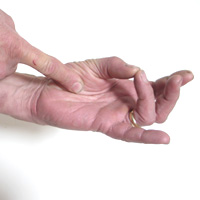
|
Thumb to Ring Finger = "Damn! I ruined another steak."
If it feels like thumb to ring finger, you weren't paying attention. When you
let that steak rest it'll turn into a chunk of wood. Feed it to the dog.
Or ... collect your wits, take it inside and cut it into strips to make
Texas-style chili! In about two hours of slow simmer with some kick-ass spices it'll be
edible again, and the chili will have a real nice smokey taste to it: But remember that you
could have made that same chili with a much cheaper piece of meat. If you're going to be a
grilling rock star you need to figure out how to do this!
|
| |
" I MEANT to do
that..." Texas Chili Recipe
2 pounds ruined steak cut
into 1/2 inch strips
1 teaspoon cumin
1 ripe tomato, chopped
1 clove garlic, minced
1 medium white onion, chopped
6 stalks celery, chopped
1 8 ounce can green chili salsa
1 8 ounce can green chile peppers, diced
1 teaspoon oregano
1 teaspoon Tabasco sauce
1 tablespoon hot chili powder
1 tablespoon medium chili powder
1 tablespoon mild New Mexico chili powder
canned tomato juice to barely cover the meat
salt to taste
Simmer until reputation is restored.
|

|

















